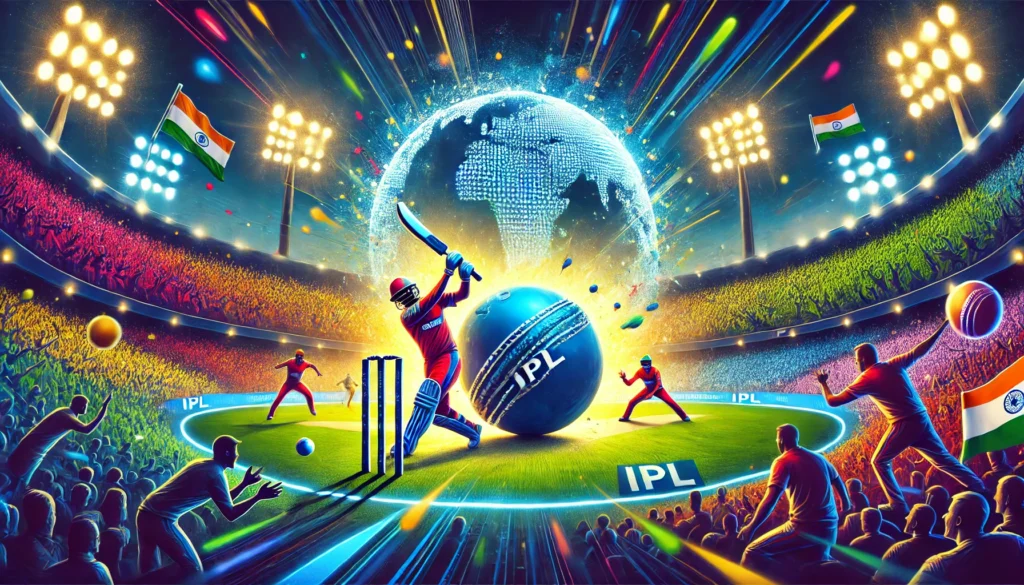The Indian Premier League (IPL) has had a profound impact on the world of cricket, reshaping the sport’s appeal on a global scale. Launched in 2008, the IPL quickly became more than just a domestic T20 league; it evolved into a global cricketing phenomenon that attracted fans, players, and investors from around the world. Its unique blend of high-octane cricket, entertainment, and marketing turned the sport into a spectacle that transcended national boundaries. By introducing the franchise-based model, the IPL brought together international players and Indian stars, creating a melting pot of cricketing talent. This approach not only elevated the standard of T20 cricket but also made the sport more accessible and exciting for a diverse audience. The league’s emphasis on fast-paced action, strategic gameplay, and star-studded matches has captivated fans worldwide, significantly increasing cricket’s visibility beyond its traditional strongholds. The IPL’s success has made it a blueprint for other leagues and has played a crucial role in establishing T20 as a globally popular format, expanding cricket’s reach and reshaping its future.
The Rise of the Indian Premier League
The rise of the Indian Premier League (IPL) is a story of vision, innovation, and overcoming challenges. Conceived as a response to the growing popularity of T20 cricket and the need for a competitive domestic league, the Board of Control for Cricket in India (BCCI) launched the IPL in 2008. The idea was to create a platform that would combine the excitement of cricket with the glamour of entertainment, thus appealing to a broader audience. The league’s format was inspired by the franchise models of American sports leagues, where teams represent cities and compete for glory. This model brought a sense of local pride and fan engagement, making the matches not just about cricket but about regional rivalries and local heroes.
The Vision Behind the IPL’s Creation
The vision behind the IPL was to take advantage of the emerging T20 format, which had gained popularity due to its shorter, more dynamic nature compared to traditional Test and ODI matches. The BCCI aimed to make cricket more viewer-friendly, especially for younger audiences with shorter attention spans. The format also offered an ideal opportunity to attract corporate sponsorships and media partnerships, as T20 matches could be completed in just a few hours, making them perfect for prime-time television. This foresight laid the foundation for the commercial success of the league.
The Early Success and Challenges
The IPL’s inaugural season in 2008 was an instant hit, featuring iconic players like Sachin Tendulkar, MS Dhoni, Shane Warne, and Adam Gilchrist, who brought their star power to the league. The matches were played in packed stadiums, and millions tuned in to watch the games on television, making it one of the most-watched cricket events of the year. However, the early success was not without its challenges. The league faced criticism from traditionalists who believed that the fast-paced T20 format undermined the spirit of the game. Additionally, managing the interests of various franchises and ensuring transparency in player auctions and governance posed significant hurdles for the BCCI.
Evolution of the Format and Fan Engagement
Over the years, the IPL evolved to become more than just a cricket league—it became a cultural phenomenon. The introduction of elements like cheerleaders, themed opening ceremonies, and strategic timeouts added an entertainment quotient that attracted even non-traditional cricket fans. The league’s fan engagement strategies, such as social media campaigns, fan clubs, and exclusive behind-the-scenes content, helped build a loyal following for each franchise. This focus on fan experience turned the IPL into a must-watch event every summer, drawing millions of viewers from across the globe.
The IPL’s rise demonstrated how cricket could adapt to modern times without losing its essence. By blending tradition with innovation, the league set a new standard for cricketing entertainment, reshaping how the sport is consumed and enjoyed worldwide.
Impact of IPL on Global Cricket Viewership and Fanbase
The Indian Premier League (IPL) has had a significant impact on global cricket viewership, transforming the way fans engage with the sport. The league’s ability to attract international cricketing stars and broadcast rights across multiple countries has expanded the fanbase of cricket far beyond its traditional regions. The IPL brought together fans from different cricketing nations, fostering a global community that tunes in to watch their favorite players compete, regardless of their national affiliations.
The inclusion of top players from countries like Australia, England, South Africa, and the West Indies has been instrumental in building this diverse fanbase. Viewers who may have previously only watched their home teams became interested in the IPL to follow their favorite international players. This cross-cultural mix in teams helped fans connect with franchises from different cities, creating a unique blend of local loyalty and international appeal. As a result, the IPL has contributed to breaking down barriers and bringing cricket enthusiasts together on a global scale.
Moreover, the league’s emphasis on entertainment, combined with strategic marketing campaigns, has made cricket more appealing to younger audiences who may not have been drawn to the longer formats of the game. With matches being broadcast in prime time and accompanied by energetic commentary, lively graphics, and real-time stats, the viewing experience is dynamic and engaging. The IPL’s broadcasting deals with major sports networks and online streaming platforms have further amplified its reach, making it possible for fans in the USA, UK, Australia, and even non-cricketing countries to follow the action.
The digital transformation has also played a key role in this growth. The IPL embraced social media platforms early on, using them to share highlights, player interviews, and interactive content that keeps fans engaged even between matches. This digital presence has not only increased viewership but has also helped the league maintain relevance in a competitive entertainment landscape. As a result, the IPL has become a major player in the global sports industry, with a fanbase that spans continents and a viewership that rivals some of the biggest sporting leagues in the world.
Top 5 Ways IPL Revolutionized Cricket’s Commercial Landscape
The Indian Premier League (IPL) has redefined the commercial landscape of cricket, creating new revenue streams and turning the sport into a lucrative industry. Here are the top five ways in which the IPL has revolutionized the business of cricket:
- Lucrative Sponsorship Deals and Brand Partnerships
The IPL has attracted some of the world’s biggest brands, from tech giants to FMCG companies, who see the league as an ideal platform for marketing. The franchise-based model allows brands to associate with teams, leading to long-term partnerships and endorsements that boost brand visibility. This has set new benchmarks for sponsorship deals in cricket, with brands willing to invest heavily in team jerseys, stadium branding, and digital campaigns. - Record-Breaking TV Rights and Media Contracts
The IPL’s broadcasting rights have been a major contributor to its financial success. Each cycle of TV rights has seen a substantial increase in value, with networks competing fiercely to secure exclusive broadcasting deals. The global reach of the IPL means that these contracts are not just limited to India but extend to international markets, making it one of the most-watched sporting leagues worldwide. - Boost to Franchise-Based Sports Leagues Worldwide
The success of the IPL has inspired the creation of similar franchise-based leagues in other sports, both in India and abroad. The model has proven that sports leagues can thrive by focusing on entertainment and fan engagement, leading to the rise of leagues like the Big Bash League (BBL) in Australia, the Caribbean Premier League (CPL), and even leagues in other sports such as football and kabaddi. - Player Salaries and the Rise of the Cricket “Superstar”
The IPL has elevated the status of cricketers, turning many into global superstars with salaries that rival those of athletes in other sports. The league’s auction process allows players to earn significantly more than they would through traditional contracts, making cricket a viable and lucrative career option. This has also encouraged cricketers to specialize in T20 cricket, focusing on skills that are in high demand during IPL seasons. - Creation of a Year-Round Cricket Calendar
The IPL has played a crucial role in creating a year-round cricket calendar that keeps fans engaged throughout the year. Its placement in the cricketing calendar ensures that there is a seamless flow from domestic leagues to international tours and back to domestic competitions. This consistency has helped maintain interest in the sport, keeping cricket at the forefront of sports entertainment.
These aspects highlight how the IPL has transformed cricket into a global business, setting new standards for profitability and player earnings, while also creating a model that other sports have sought to emulate.
How IPL Influenced the T20 Format Globally
The IPL has had a profound influence on the T20 format, shaping how the game is played, perceived, and enjoyed around the world. The league’s emphasis on aggressive batting, strategic bowling, and innovative field placements has led to the evolution of T20 cricket as a format that prioritizes high energy and unpredictability. Many of the strategies developed and popularized in the IPL, such as powerplay dynamics, death-over bowling techniques, and the use of mystery spinners, have become standard in T20 cricket worldwide.
Adoption of T20 Leagues in Other Countries
One of the most significant impacts of the IPL has been the proliferation of similar T20 leagues in other countries. Leagues like the Big Bash League (BBL) in Australia, the Pakistan Super League (PSL), and the Caribbean Premier League (CPL) have drawn inspiration from the IPL’s success. These leagues have adopted the franchise model and have incorporated elements such as player drafts and auctions to create competitive and entertaining tournaments. The IPL has set a benchmark for how T20 leagues should be organized, ensuring high standards in broadcasting, fan engagement, and player management.
Changes in Player Training and Strategy
The influence of the IPL extends to how players train for the T20 format. The high-intensity nature of the league has led to the development of specialized training regimens that focus on power hitting, yorker-length bowling, and athletic fielding. Players have adapted to the demands of the format, learning to innovate in the face of pressure, and this has led to more dynamic gameplay in T20 matches around the world. The IPL’s emphasis on data analysis and match simulations has also been adopted by international teams, leading to more strategic approaches to the T20 game.
The T20 World Cup’s Growing Popularity
The popularity of the IPL has contributed to a surge in interest for the ICC T20 World Cup, making it one of the most anticipated events in the cricketing calendar. The league has provided a stage for players from different nations to test their skills against each other, which in turn has raised the standard of competition at the T20 World Cup. As players build rivalries and partnerships in the IPL, these narratives carry over to international tournaments, enriching the fan experience and adding layers of excitement to T20 cricket.
The Future of Cricket in the Post-IPL Era
The future of cricket in the post-IPL era is likely to be shaped by the trends and standards that the league has established. As the IPL continues to attract global talent and set new records for viewership and revenue, it will remain a central figure in the evolution of cricket. However, the focus may shift towards ensuring that the balance between franchise leagues and international cricket is maintained, allowing players to compete at the highest levels while preserving the integrity of bilateral series.
The IPL’s success has opened up discussions about the sustainability of the cricket calendar and the need to manage player workloads. It has also highlighted the importance of innovation in keeping the sport relevant to younger audiences. As cricket expands into new markets and embraces digital platforms, the legacy of the IPL will continue to shape its growth, ensuring that the sport remains vibrant and globally appealing. With the right balance, the IPL’s influence could help cricket reach new heights, solidifying its place as a truly global game.



